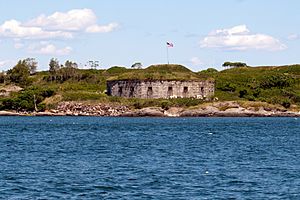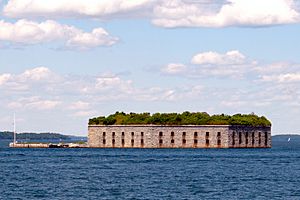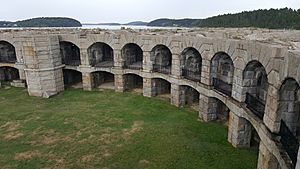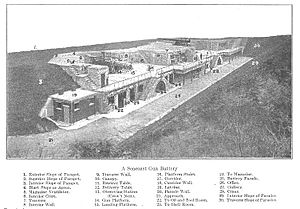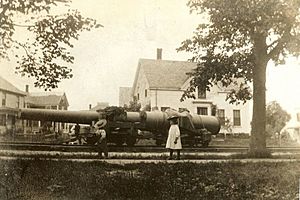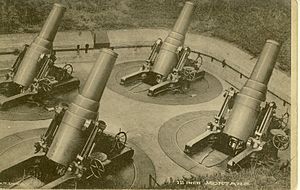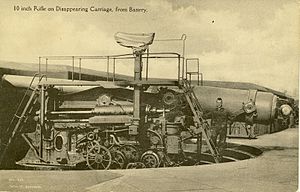Harbor Defenses of Portland facts for kids
Quick facts for kids Harbor Defenses of Portland |
|
|---|---|
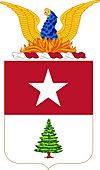
Coat of arms
|
|
| Active | 1895-1950 |
| Country | |
| Branch | United States Army Coast Artillery Corps |
| Type | Coast artillery |
| Role | Harbor Defense Command |
| Part of |
|
| Garrison/HQ |
|
| Motto(s) | Terrae Portam Defendamus (We Defend The Land Gate) |
| Mascot(s) | Oozlefinch |
The Harbor Defenses of Portland was a special military group. It was part of the United States Army Coast Artillery Corps. This group was in charge of protecting the coast around Portland, Maine. They also guarded the mouth of the Kennebec River. Their job lasted from 1895 to 1950.
This defense system included strong forts with big guns. It also used underwater minefields. The group started around 1895 as the Portland Artillery District. It was later called the Coast Defenses of Portland in 1913. In 1925, it got its final name, Harbor Defenses of Portland.
Contents
What Were the Coast Defenses of the Kennebec?
The Kennebec coast defense command might have started around 1895. This was when minefield support was set up. It happened at Fort Popham in Phippsburg. Mines were even used there during the Spanish–American War.
It is not fully clear if the Coast Defenses of the Kennebec was a separate group. It might have always been part of the Coast Defenses of Portland. Before 1917, these two commands joined together.
Between 1905 and 1912, Fort Baldwin was built near Fort Popham. It was a smaller fort with three 6-inch guns and two 3-inch guns. During World War I, soldiers from the Coast Defenses of Portland guarded these forts. Fort Baldwin's guns were removed in 1924. However, the minefield at Fort Popham might have stayed active.
In World War II, Fort Baldwin got new guns. These were four 155 mm guns on special mounts. They were operated by Battery D of the 8th Coast Artillery.
A Look Back at Portland's Forts
Early Forts and Their Purpose
A Revolutionary War battery once stood where Fort Allen Park is today. Some say it was called Fort Allen back then. In 1794, Fort Sumner was built in Portland. It had a blockhouse and a water battery. This fort was part of the first system of US fortifications.
More forts were built later. Fort Preble and Fort Scammell were finished in 1809. Fort Preble was in what is now South Portland. Fort Scammell was on House Island. These forts were built because people worried about war with the British.
The forts were first used to enforce the Embargo Act of 1807. This law stopped trade with Britain and France. Many local people did not like this law. During the War of 1812, Portland used its own money to fix and rearm Fort Allen. This happened after the British captured nearby towns.
Fort Preble was made bigger in 1845. Fort Scammell's walls were also extended around this time.
Building More Forts for Protection
From 1858 to 1862, new forts began to be built in Portland harbor. This was part of the third system of US fortifications. Work on Fort Gorges started in 1858. It was on a small island.
After the Civil War began in 1861, Fort Scammell was rebuilt. Fort Preble was also updated. By the end of the war, Fort Gorges was mostly done. Fort Scammell's design was simplified to finish it faster. Fort Preble's new batteries were never completed.
In the 1870s, these forts were changed. They got earthwork batteries for Rodman guns. Funding stopped in 1876. It took over 20 years for modern gun batteries to be built.
The Caleb Cushing Incident
The only enemy action in Portland harbor since the Revolutionary War happened on June 27, 1863. It was called the Battle of Portland Harbor. Confederate raiders captured a fishing boat. They then took the US Revenue Service cutter Caleb Cushing. They tried to escape the harbor.
About 30 soldiers from Fort Preble and 100 civilians helped. They used steamships with light artillery. The Confederates avoided the forts. But the wind changed, and the Union ships caught up. The Confederates set fire to the Cushing and left the ship. All the Confederates were captured.
The Endicott Period: Modernizing Defenses
In 1885, the Endicott Board suggested new forts. Construction began in 1893 on five forts for Portland harbor. When the Spanish–American War started in 1898, some gun batteries were quickly put in place. People worried the Spanish fleet might attack the US east coast.
By 1903, the main Endicott gun and mortar batteries were finished. All batteries were done by 1906. The southern harbor entrance had three forts: Fort Williams, Fort Levett on Cushing Island, and Fort Preble. The northern entrance had Fort McKinley and Fort Lyon.
Two underwater minefields also protected the harbor. Fort Williams had two 12-inch and five 10-inch guns. Fort Levett had three 12-inch and two 10-inch guns. Fort Preble had sixteen 12-inch mortars. Fort McKinley had eight 12-inch mortars, two 12-inch guns, and eight 8-inch guns. Each fort also had 6-inch and 3-inch guns. Fort Lyon was the smallest.
World War I Changes
When America joined World War I, the Coast Artillery changed a lot. They were the only Army group with heavy artillery experience. So, they were chosen to operate most US heavy and railway artillery. Soldiers were sent from forts to fight in Europe.
Some weapons were removed from forts. They were meant to be used in the war. For example, 8-inch, 10-inch, and 12-inch guns became railway artillery. 5-inch and 6-inch guns became field guns. However, few of these guns saw action before the war ended.
Two 10-inch guns from Fort Williams and seven 6-inch guns from other forts were removed. After the war, some of these guns were returned. The mortar batteries at Forts Preble and McKinley were cut in half. This helped them fire faster. Many temporary buildings were built at the forts for new soldiers.
The Coast Defenses of Portland had 29 companies. This included 13 from the Maine National Guard. Nine of these companies formed the 54th Coast Artillery. This group went to France but became a training unit. They returned home after the war.
Between the World Wars
In January 1921, Battery Foote at Fort Levett was finished. This battery had two 12-inch guns. These guns could shoot much farther than older ones. They were later covered with concrete for protection.
On July 1, 1924, the harbor defense groups changed. They went from being company-based to regimental. On June 9, 1925, their names changed from "Coast Defenses..." to "Harbor Defenses...". The 8th Coast Artillery was the main Army group for Portland's defenses. The 240th Coast Artillery was the National Guard group. During this time, 155 mm guns were based at Fort Williams.
World War II: New Defenses
At the start of World War II, the forts grew quickly. Many temporary buildings were added for new soldiers and equipment. The 240th Coast Artillery started active duty on September 16, 1940. After the Fall of France in 1940, the Army decided to use 16-inch guns.
In 1942, work began on Battery Steele at the Peaks Island Military Reservation. This battery had two 16-inch guns. It was mostly finished by late 1944. The main defense for Portland became Peaks Island, the 12-inch Battery Foote, and the minefields. Most of the older Endicott-era guns were removed and scrapped between 1942 and 1944.
To help the big guns, three new batteries of 6-inch guns were built. They were on Peaks Island, at Two Lights, and on Jewell Island. But only the Peaks Island battery was armed. Some older 6-inch and 3-inch gun batteries were kept. New 3-inch gun batteries were built on Peaks Island, Long Island, and Great Chebeague Island.
Ten Anti-Motor Torpedo Boat (AMTB) batteries were also placed around Casco Bay. These had 90 mm guns and 40 mm Bofors guns. These guns could shoot at both air and surface targets. They were at various islands and forts.
Battery D of the 8th Coast Artillery had four 155 mm guns. They were sent to Fort Baldwin from 1942 to 1944. Another similar battery went to Biddeford Pool. In 1944, most soldiers from the 8th Coast Artillery were moved to HD Portland. The 240th Coast Artillery was reorganized into two battalions in 1944. These units were stopped on April 1, 1945.
After 1940, HD Portland was under the First Army. On December 24, 1941, the Eastern Theater of Operations was created. All east coast harbor defense commands were under it. This included antiaircraft and fighter planes. This command ended in 1946.
The US Navy also helped protect Casco Bay. They used net defenses and special loops to find submarines. Stations were at Fort Williams, Peaks Island, Cape Elizabeth, and Bailey Island.
Casco Bay saw action only once in World War II. The USS Eagle 56 (PE-56) exploded and sank on April 23, 1945. This happened a few miles east of Cape Elizabeth. At first, it was thought to be a boiler explosion. But in 2001, the Navy said that a German U-boat, U-853, torpedoed it. This U-boat was sunk later in May 1945.
After World War II
After the war, it became clear that gun defenses were no longer needed. They were removed within a few years. By 1948, this was complete. The Navy took over any remaining defense jobs. On January 1, 1950, the Coast Artillery Corps and all Army harbor defense commands were officially ended. Today, the Air Defense Artillery continues the history of some Coast Artillery units.
What Can You See Today?
As of 2016, Fort Allen Park has two rebuilt gun positions. They have Civil War-era guns and war memorials. You can see a 6-inch gun from the USS Maine. You can also see parts of the USS Portland. There is no trace left of Fort Sumner's blockhouse.
Southern Maine Community College is now on the site of Fort Preble. Some batteries and buildings are still there. You can get good views of Fort Scammell and Fort Gorges. You can visit Fort Gorges by boat. It has an unmounted 10-inch Parrott rifle on its roof.
Forts Scammell and Levett are well-preserved. But they are on private islands, so you need permission to visit. Battery Steele and the 6-inch battery on Peaks Island are also well-preserved. The 6-inch battery is now part of a private home.
The 6-inch batteries on Jewell Island and at Two Lights State Park are still there. The battery at Two Lights has a sign with a diagram. Several fire control towers can still be seen around Casco Bay.
Fort Williams is now Fort Williams Park. Most of its batteries were buried in the 1980s. Most buildings were removed to create green space. One 12-inch gun position is partly buried. The 3-inch Battery Keyes is still fully preserved.
Fort McKinley and its buildings are mostly intact. However, most of the gun positions are overgrown. Forts Popham and Baldwin are well-preserved. Fort Baldwin is open to the public. You can see the inside of Fort Popham from the back.
Coat of Arms: What Do the Symbols Mean?
Shield and Crest Details
- Shield: The top half is red, the bottom half is white. In the red part, there is a white star. In the white part, there is a green pine tree.
- Crest: On a red and white wreath, a purple phoenix with gold wings rises from flames.
- Motto: TERRAE PORTAM DEFENDAMUS (We Defend The Land Gate).
Understanding the Symbols
- Shield: The star has two meanings. Its five points stand for the five forts in the Coast Defenses. It also represents the North Star, as these were the northernmost defenses. The red background is for artillery. The pine tree is the symbol of Maine. It is on a white background, like the snow where this type of pine grows. The motto means "We Defend the Land Gate." "Terrae Portam" is also Latin for Portland. "Defendamus" is the motto of the Coast Artillery Corps.
- Crest: The crest comes from the city of Portland's own symbols. Portland was burned down three times in wars. It was destroyed by Native Americans in 1676, by the French in 1690, and by the English fleet in 1775. But each time, it rose again like a phoenix from its ashes.
History of the Coat of Arms
This coat of arms was first approved in 1919 for the Coast Defenses of Portland. It was later approved for the 8th Coast Artillery Regiment in 1924. The motto's translation was corrected in 1928. The symbol was given to the 27th Antiaircraft Artillery Automatic Weapons Battalion in 1952.


